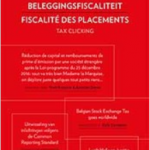To outside observers, including many Europeans, the outcome for banks and other financial institutions under the recent U.S. tax act was surprising. The U.S. Senate and House of Representatives each passed the Tax Cuts and Jobs Act (the “Act”) in the same form in December 2017, as is required for any U.S. Federal legislation. President Trump then signed the Act into law on December 22, 2017.
As informed observers know, the Act represents the first major U.S. tax legislation since the financial crisis of a decade ago and, indeed, the most farreaching reform of U.S. taxation since 1986. However, no major provisions of the Act were targeted specifically at the financial industry, which is not a result that would have been expected following the recent financial crisis and the proposals for special tax provisions which have been made in the ensuing years. As will be discussed in greater detail below, the provisions of the Act that impact the financial industry are unlikely to be all that detrimental. More important for banks and other financial institutions is likely to be the general tax rate cut under the Act — a reduction of the general corporate income tax rate from 35 to 21 percent.
[…]
The Act is a huge piece of legislation, comprising 185 pages. […] In the past, major U.S. tax legislation has been followed by shorter enactments providing for “technical corrections” of the earlier law. However, in the current, politically charged atmosphere prevailing in the U.S. Congress, it is unlikely that such legislation will be passed soon with respect to the Act. Thus, many open questions remain as to the application of the Act’s provisions to banks and others. With that caveat, we turn to a description of the provisions of the Act most relevant to banks and other financial entities.
-
Limits on deduction of FDIC Premiums
The only provision of the Act dealing specifically with banks is the limitation on the deduction of insurance premiums paid to the Federal Deposit Insurance Corporation (“FDIC”) The FDIC is a U.S. government corporation that is the main insurer of depositors in U.S. banks. […] Thus, the Act denies large banks (and only large banks) the additional benefit of a deduction for their FDIC premiums.
-
General provisions of the act of significance to the financial industry
[…]
a. Reduction in Corporate Taks Rate to 21Percent
The Act reduces the corporate income tax rate from 35 percent to 21 percent, generally effective for taxable years beginning after December 31, 2017. […] It worth clarifying that the new 21 percent rate will apply not only to U.S. subsidiaries of European groups, which are taxed as U.S. corporations in all respects, but also to European companies which do business in the U.S. in branch form. Like most countries, the U.S. taxes all income “attributable” to a European branch in the United States at the normal corporate rate.[1] Thus, the new 21-percent rate will apply to U.S. branch income as well. […]
b. New NOL Limitations
[…] Under the Act, NOLs may now be carried forward indefinitely, but generally cannot be carried back to prior taxable years. These changes to carryforwards and carrybacks apply to losses arising in taxable years ending after December 31, 2017.[2]
c. Limitations on Interest Expense Deductions
[…]
d. “Carried” Interests of Partnerships
Widely proposed and expected by many was a tightening or elimination of the benefits of “carried interests” or “profits interest” of partnerships. In the end, the Act tightened these rules only slightly, however. Because these rules affect only entities treated as partnerships for U.S. tax purposes, they are of interest chiefly to hedge funds and other investment funds, rather than to banks themselves. […] The Act does not change the general U.S. Federal income tax treatment of carried interests as partnership interests that pass through items of partnership income, including capital gain, and does not appear to cause the grant of a carried interest to be treated as compensation for services.
-
Payment to related non-U.S. entities
Having dealt with the general provisions and the one specific provision targeted at banks, we come to some important new provisions that can negatively affect banks and other financial entities with regard to their payments to related non-U.S. entities. European financial institutions which do business in the U.S. through U.S. subsidiaries will be fully subject to these rules with respect to the payments they make to their European parents and other non-U.S. entities in the group.
a. Base Erosion and Anti-Abuse Taks
The Act imposes the Base Erosion and Anti-Abuse Tax (“BEAT”), a new, complex regime for U.S. corporations with certain deductible payments made to related foreign parties. The BEAT is a minimum tax imposed in addition to, not in lieu of, a U.S. corporation’s regular tax liability. The tax — called the “base erosion minimum tax amount” — is the amount by which a statutory percentage of the U.S. taxpayer’s “modified taxable income” exceeds its regular U.S. tax liability. […]
b. Anti-Hybrid Rules
The Act disallows deductions for “disqualified related party amounts” paid or accrued pursuant to a hybrid transaction or by or to a hybrid entity. […] Kent Killelea en Howard Liebman voetnoten [1] Technically, the “attributable” standard applies only to branches of companies in countries that have an income tax treaty with the United States. Almost all European countries fall in this category. For other branches, the standard under U.S. law is income that is “effectively connected” with the branch. In practice, the two standards are very similar. [2] The effective date rule in the final Act is different from the rule described in the Conference Report, which provided that the changes to carryforwards and carrybacks would apply to losses arising in taxable years beginning after December 31, 2017. H. Rep. 115-466, Dec. 15, 2017, pp. 393-94. We understand that the Conference Report language is what was intended, but this is one of those items which needs to be clarified or corrected.
Benieuwd naar meer maatregelen uit de “U.S. Tax Act” die invloed hebben op de Europese financiële markt? U kan het volledige artikel van Kent Killelea (Jones Day, Washington D.C.) en Howard Liebman (Jones Day Brussels en voorzitter van Amcham Belgium), lezen in het recente themanummer over de “U.S. Tax Reform” van het Tijdschrift Beleggingsfiscaliteit. Meer info en abonnementsvoorwaarden vindt u hier.  Voor de camera van Advocatennet sprak de hoofdredacteur van het Tijdschrift Beleggingsfiscaliteit, Dirk Coveliers, over hoe de internationale samenwerking voor het themanummer “U.S. Tax Reform” precies tot stand kwam. U kan het fragment hieronder integraal bekijken.
Voor de camera van Advocatennet sprak de hoofdredacteur van het Tijdschrift Beleggingsfiscaliteit, Dirk Coveliers, over hoe de internationale samenwerking voor het themanummer “U.S. Tax Reform” precies tot stand kwam. U kan het fragment hieronder integraal bekijken.




0 reacties